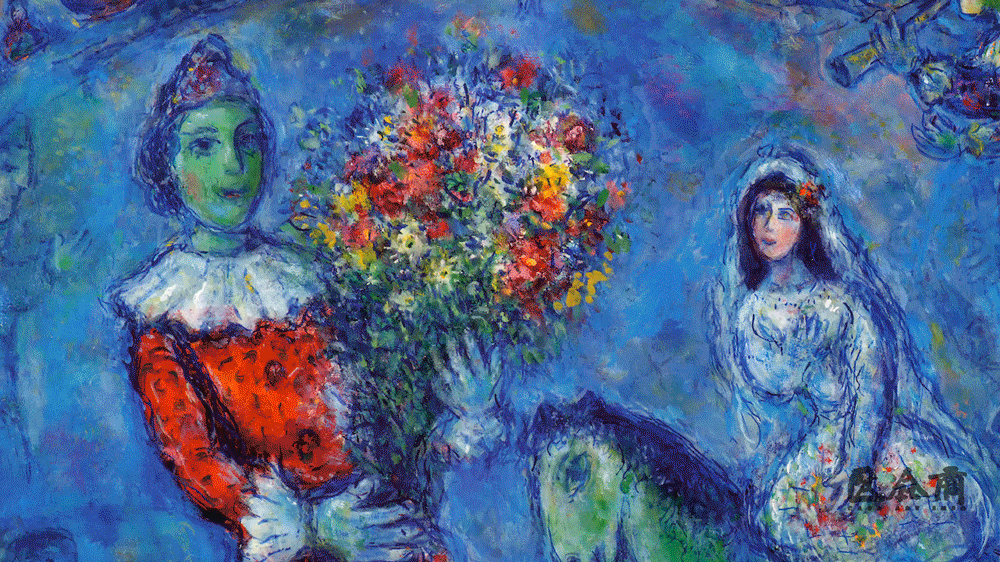
Editor’s note: On October 9th, 2020, the debut show of “Marc Chagall” in China was unveiled at CAFA Art Museum—Langfang. The exhibition is divided into five sessions of “Love, Nostalgia, Fantastic World and Circus” and “Classic Etchings: La Fontaine’s Fables”, “Faith and Vitality: The Bible Series”, “Paris Seduction”, and “Life Ends with a Bouquet of Flowers”, a total of 155 works are exhibited, covering oil paintings, watercolors, gouaches, tempera as well as etchings and other art forms. In these works, whether they depict themes such as hometown, lover, circus, flowers, etc., or use art forms such as oil painting, watercolor, printmaking, etc., Chagall always constructs the world through his eyes and his inner emotions using a dreamy and surrealistic language.
Marc Chagall was a talented artist in the 20th century. Since he took the initiative to step out of the “Pale of Settlement” at the age of 19, his art has been like his life, dominated by himself. When the development of modern art in Paris was in full swing, Chagall began to accept the baptism of art. Although he was surrounded by the influences of many genres of art such as Impressionism, Fauvism, and Cubism, he always maintained his own painting characteristics. His Jewish identity and religious influence have always been hidden in his art. The bright colors and dreamy composition have always focused on portraying his lover and hometown. He has become a great master of art who expresses his spiritual world with brushes and touches the whole world.
Identity and Religion
When talking about Chagall, his identity as a “Jewish artist” is inevitable. For a long time, Judaism has restricted the developments in the art of painting. The “Ten Commandments of Moses”, which is regarded as a living standard by the Jews, stipulates: “You must not sculpt idols for yourself, and you must not make them based on objects in the sky, on the earth, underground, or beneath water.” Therefore, Jews made more developments in literature and performing arts. Born in a traditional family that believes in Judaism, Chagall’s parents were engaged in a small business that Jews were usually good at, and his future life was planned early for him to be a clerk or an accountant. “Art” and “artist” for Chagall were pie in the sky at that time. He said: “The word ‘painter’ is so strange and so rich in literature, it seems to have flown in from another world, it may fall on my head, but no one in our small town would ever say this word as this is something very far away from us.”
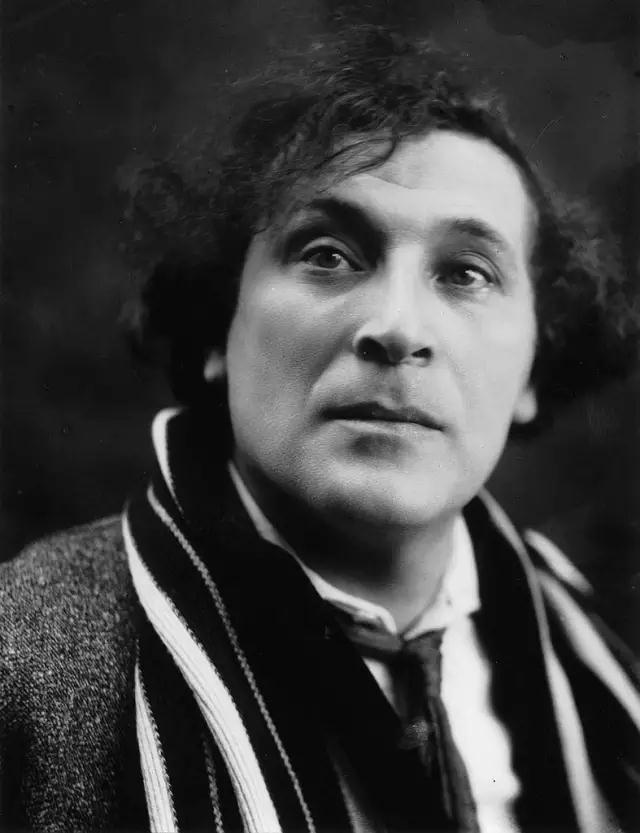
Marc Chagall (1887-1985)
During the period from the end of the 18th century to the Russian Revolution in 1917, Russian Jews were massacred. About 5 million people were subjected to political oppression and illegal discrimination. They were required to not leave the designated “Pale of Settlement” under any circumstances. But the Jews have always firmly preserved their religious beliefs and cultural education, which Arnold Toynbee calls a model of the diaspora society. Despite living in poverty, Chagall was not lacking in a fundamental education. He gained faith in Judaism from his family education at a young age. After going to school, he was exposed to knowledge of the basic laws of Judaism and strengthened his national consciousness.
Vitebsk is located in the northeast corner of the “Pale of Settlement”. As an important commercial center and railway transportation hub, Vitebsk first welcomed the cultural ideas from Russia and Western Europe at the end of the 19th century, with the political liberation and the demand for cultural identity. There appeared Jewish artists pursuing secular art. Although there was still a sense of opposition in Russian society then, a group of people rose up to fight. The painting and design school established by Lithuanian Jew Yehuda Pen aimed to train Jewish artists. Chagall who liked to paint joined it to learn the basic skills of painting, his artistic talent was also revealed during that period.
When he was 19 years old, Chagall carried 27 rubles that his father waved under the table, went to St. Petersburg with friends to study art and later on to Paris. Although he left his hometown in his youth, the influence of Judaism was rooted in Chagall’s blood, he was educated by rabbis when he was a child, his parents were devout believers, his grandfather was a church choir leader, and he was extremely excited to follow his grandfather into the church: “The ritual started. Grandpa was invited to the altar to pray. He prayed and sang hymns and repeatedly sang complicated tunes. At this time, there seemed to be a small wheel in my heart spinning in the oil paint, and I felt as if fresh honey was flowing in my veins.”
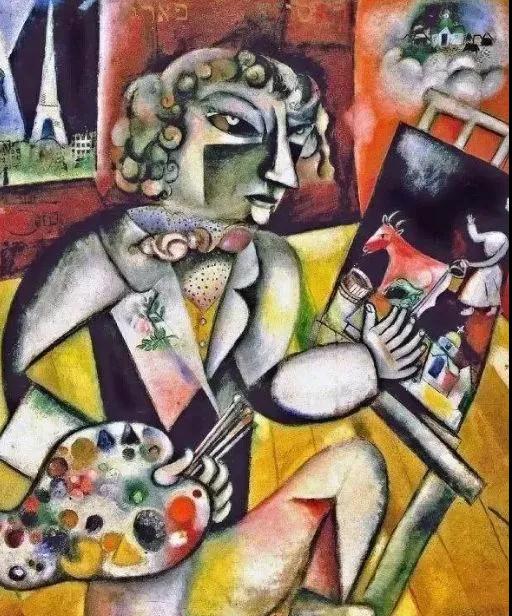
Marc Chagall, Self-portrait with Seven Fingers, oil painting, tempera, acrylic, 1912
The influence of Judaism, on the one hand, is condensed in Chagall’s creation with religious metaphors, and on the other hand, it often urges him to portray biblical subjects. The former is like the violin that often appears in Chagall’s works and a series of anthropomorphic depictions of animals, the violin is an instrument used in Judaism at important moments in a person’s life, and it is also the most typical Jewish instrument; Judaism believes that livestock is the victim of humanity’s cleansing of sins. The latter, such as “Solitude” (1933) painted after Hitler came to power, and “Martyrs” (1940) and “Yellow Crucifixion” (1943) painted many times during World War II.
Chagall believes in the Hasidic mysticism of Judaism. This school emphasizes the integration with God through fanatical prayer. A believer needs to perceive His invisible existence in life. This also explains that in Chagall’s art, anthropomorphic animal images such as horses flying in the air, fish playing the violin, sheep walking upright are often seen. With these seemingly inconsistent existences, the artist obtains a sense of spiritual satisfaction, and is endowed with spirituality, a livestock equal to human beings, mixed with the multiple time and space created by the artist, and the artist obtains the dialogue between “Me and You”, that is, a communication between me and an invisible God. The mystery claimed by the Hasidic school leaves a dreamy and mysterious background to Chagall’s art, which is why Chagall is described as “an artist full of religious mystery.”

Marc Chagall, Fiddler on the Roof, oil on canvas, 188×158cm, 1912
Theme and Emotion
Chagall drifted among many modern art schools such as Impressionism, Fauvism, Cubism, and traveled across multiple countries throughout his life, experiencing different cultures, but he still maintained his own style. He appeals to the world and real emotions in his eyes, and the most touching thing is his depiction of love and hometown.
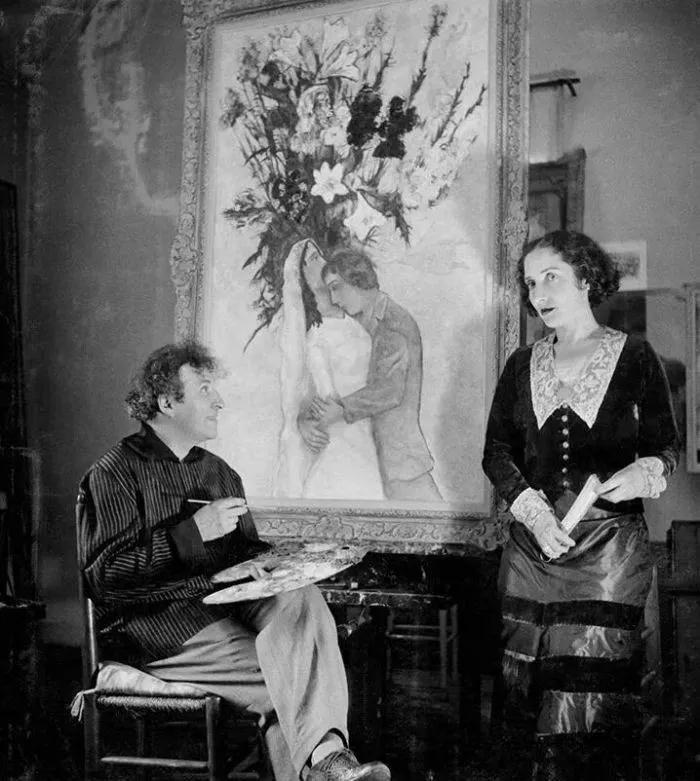
Marc Chagall and wife Bella Rosenfeld
“As soon as I opened the bedroom window, I saw the blue sky, love, and flowers floating in with her.” Chagall played with the warmth and charm of love with a brush full of spirituality. He was hailed as “a violinist that God deliberately descended to the world to praise love. “Love” was inspired by his beloved wife Bella Rosenfeld. The two met on the way back to Vitebsk from St. Petersburg. Later, Chagall tirelessly painted his lover who brought him passionate emotions and created a series of “Birthday” (1915), “Walk” (1917-1918), “Over the Town” (1918), etc.. The couple in the painting are always immersed in love and cannot be separated. They hug, hold hands, or kiss, floating on the streets of their hometown, standing under the quiet night sky, and appearing in the beautiful Paris sky…
Unfortunately, in 1944, Bella, his beloved wife, who had been with him for nearly 30 years, passed away after contracting a virus. Although Chagall had other partners later, Bella was always his spiritual guide. Chagall said: “Her silence belongs to me, her eyes belong to me. It seems that I have known her before, she knows my childhood, my present, and my future; it is as if she has been watching me and can perceive the deepest part of my soul...I know that she is my destiny, my other half...” Until his later years, Chagall never gave up on using his brush to remember and pursue his own muse.
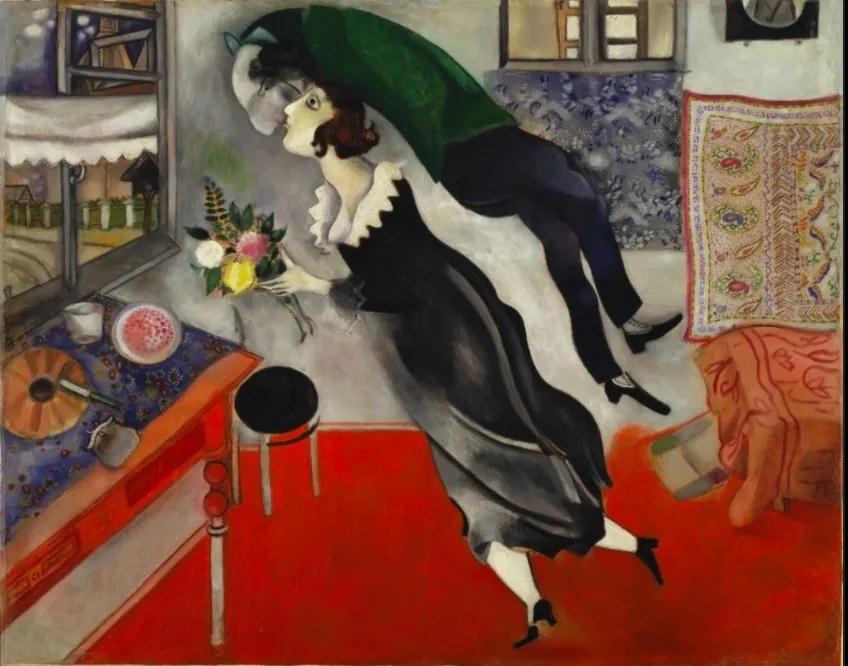
Marc Chagall, Birthday, 80.6cm × 99.7 cm, oil on canvas, 1915
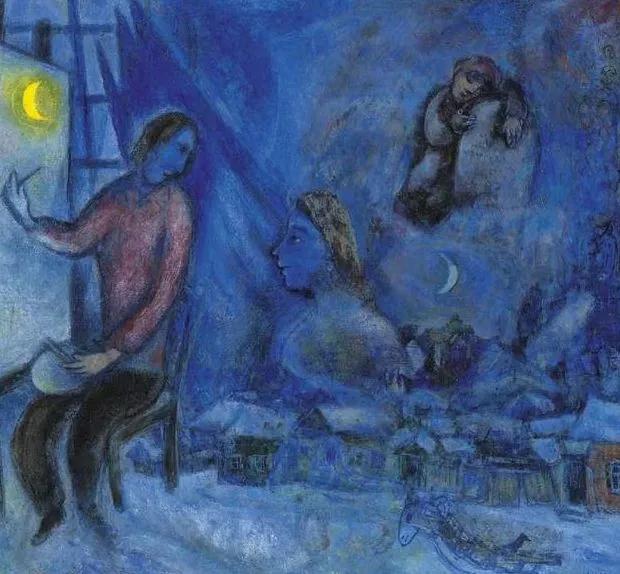
Marc Chagall, Hommage au passé ou La ville, 1948

Marc Chagall, The Violet Rooster, mixed material painting, canvas, oil paint, ink, 89.3×78.3cm, 1966-1972
“Hometown” is also the theme of Chagall’s nostalgia. In 1906, Chagall left his hometown with friends and went to St. Petersburg. Here, he relied on receiving funding to study art at the academy. On the one hand, he was influenced by Russian avant-garde art, and on the other hand, he began to yearn for Paris. His quest for art meant he kept searching. He was getting farther and farther from his “hometown”, but his heart remained so close. He said: “I always miss my hometown, which can be seen in almost all my paintings.” He knew well the meaning of his hometown for himself: “Even when I come to Paris, my shoes are still stained with Russian soil; from a foreign land thousands of miles away. The foot sticking out of my consciousness keep me standing on the ground that has nourished me, and I cannot brush the Russian soil from my shoes.” In Paris, the image of his hometown has never been far away.
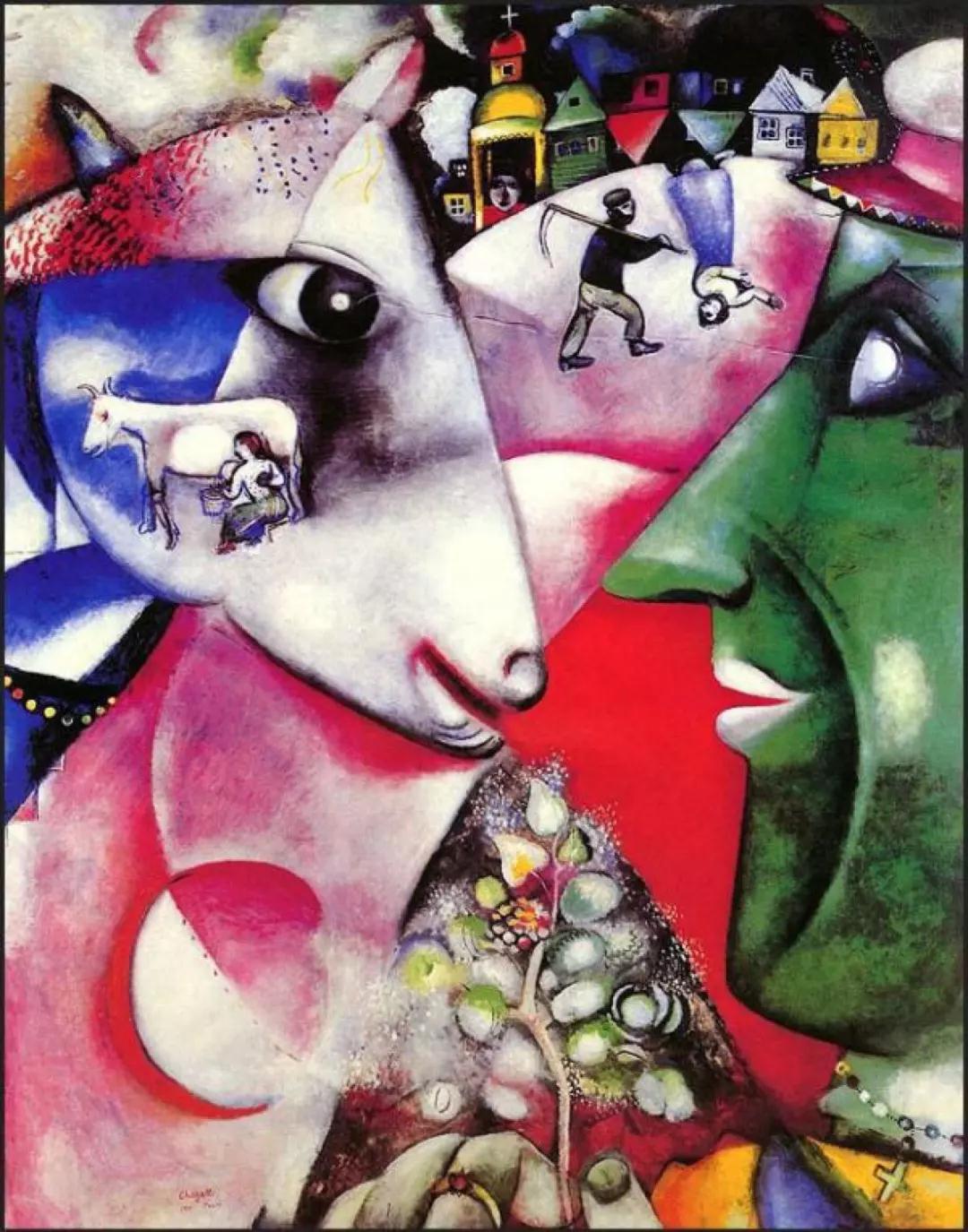
Marc Chagall, I and the Village, oil on canvas, 192x151cm, 1911
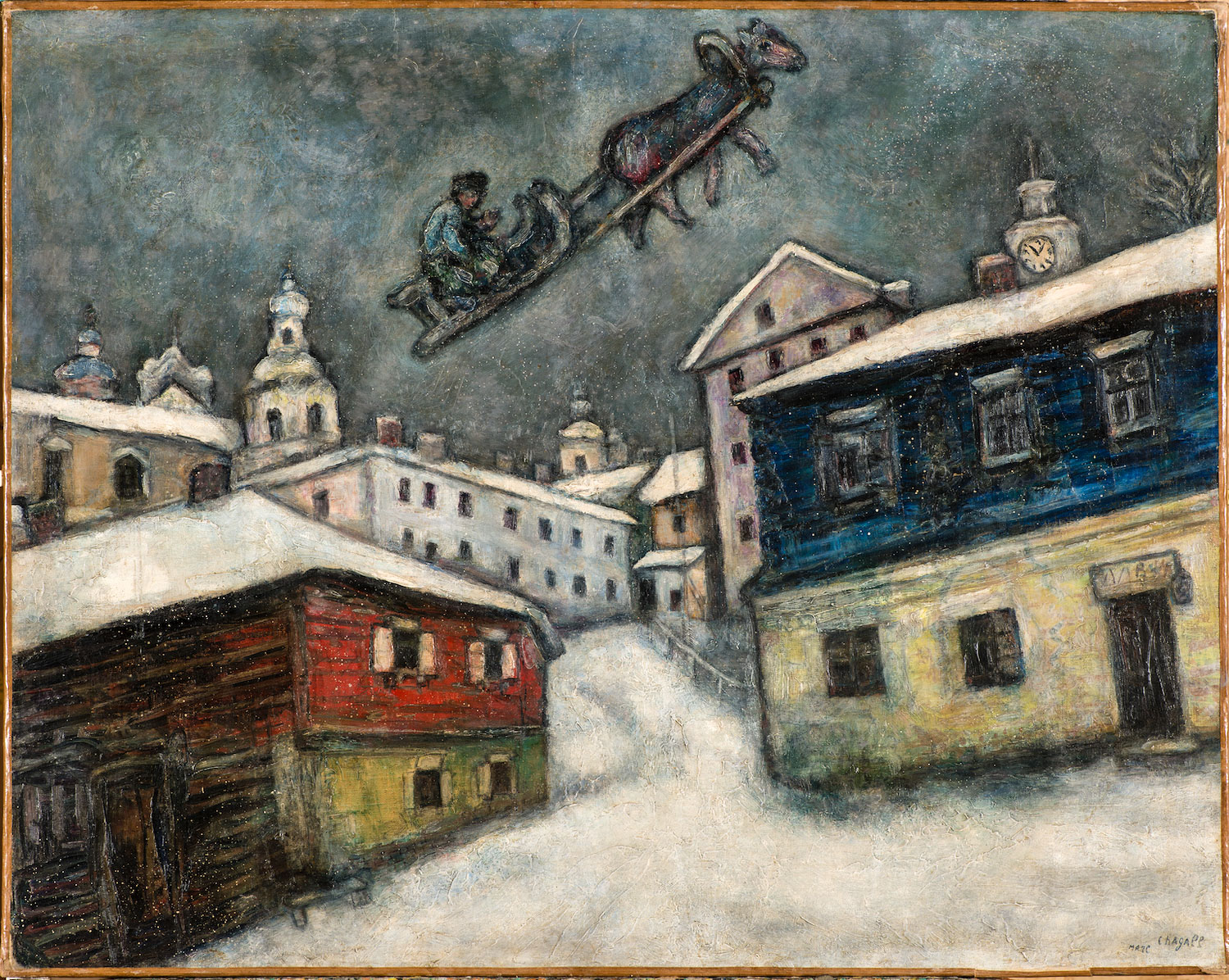
Marc Chagall, Russian Village, oil on canvas, 73x92cm, 1929
After 1910, Chagall stayed in many countries because of wars and artistic activities. From the initial depiction of the village to the later addition of the scenery of his hometown, Chagall’s hometown themes have become more abundant. He moved his family to Paris and became a French citizen. He stated that: “Paris, you are my second Vitebsk.” Obviously, whether it is realistic or emotional, Paris has become Chagall’s second hometown. Cultural elements such as the Eiffel Tower, Notre Dame Cathedral, and Louvre were gradually incorporated into the expression of Chagall’s hometown theme, becoming a treasure house of Chagall’s art and memories, and also carrying the artist’s delicate emotions.
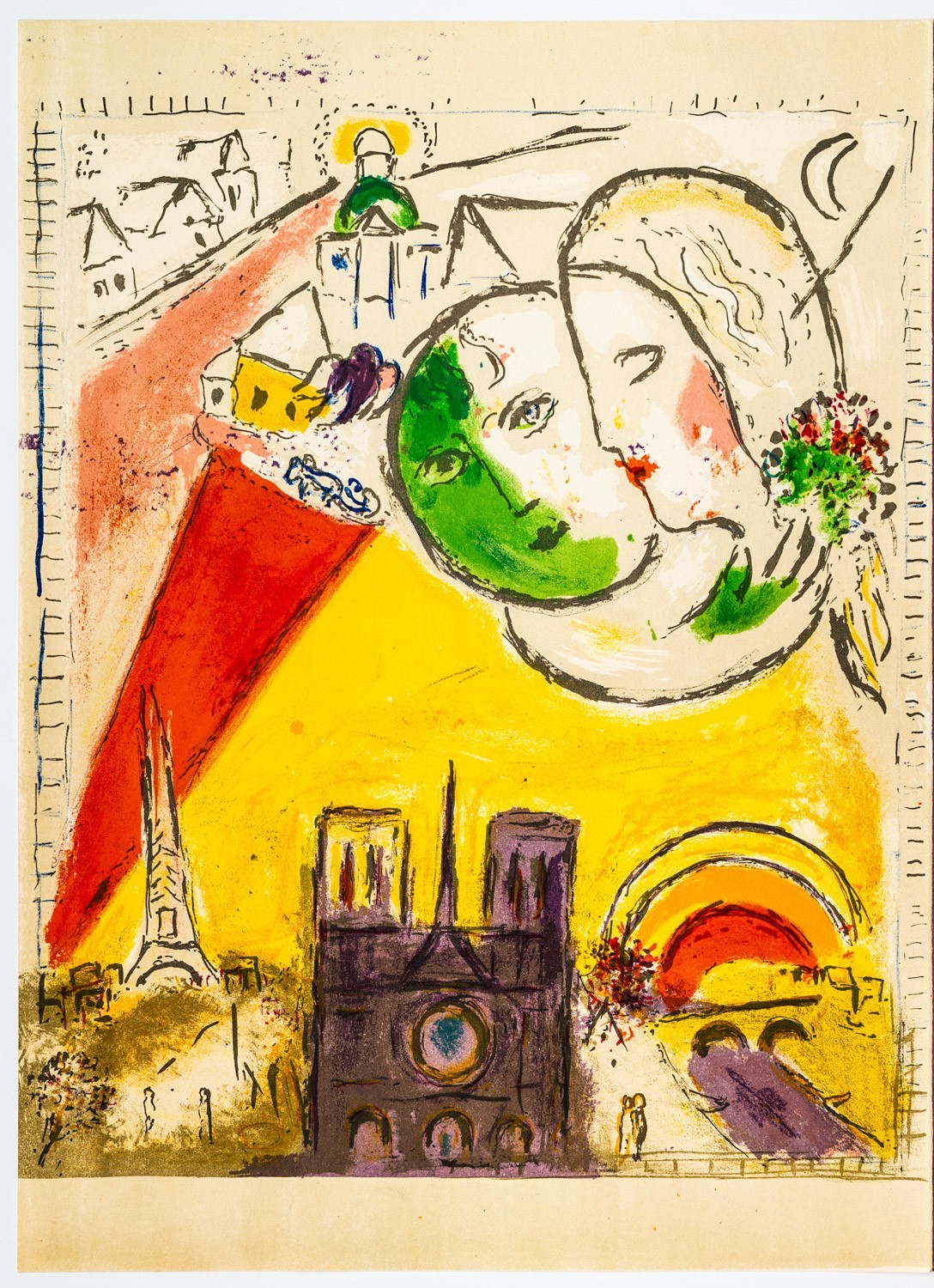
Marc Chagall, On Sundays, lithograph, 28×38cm, 1954
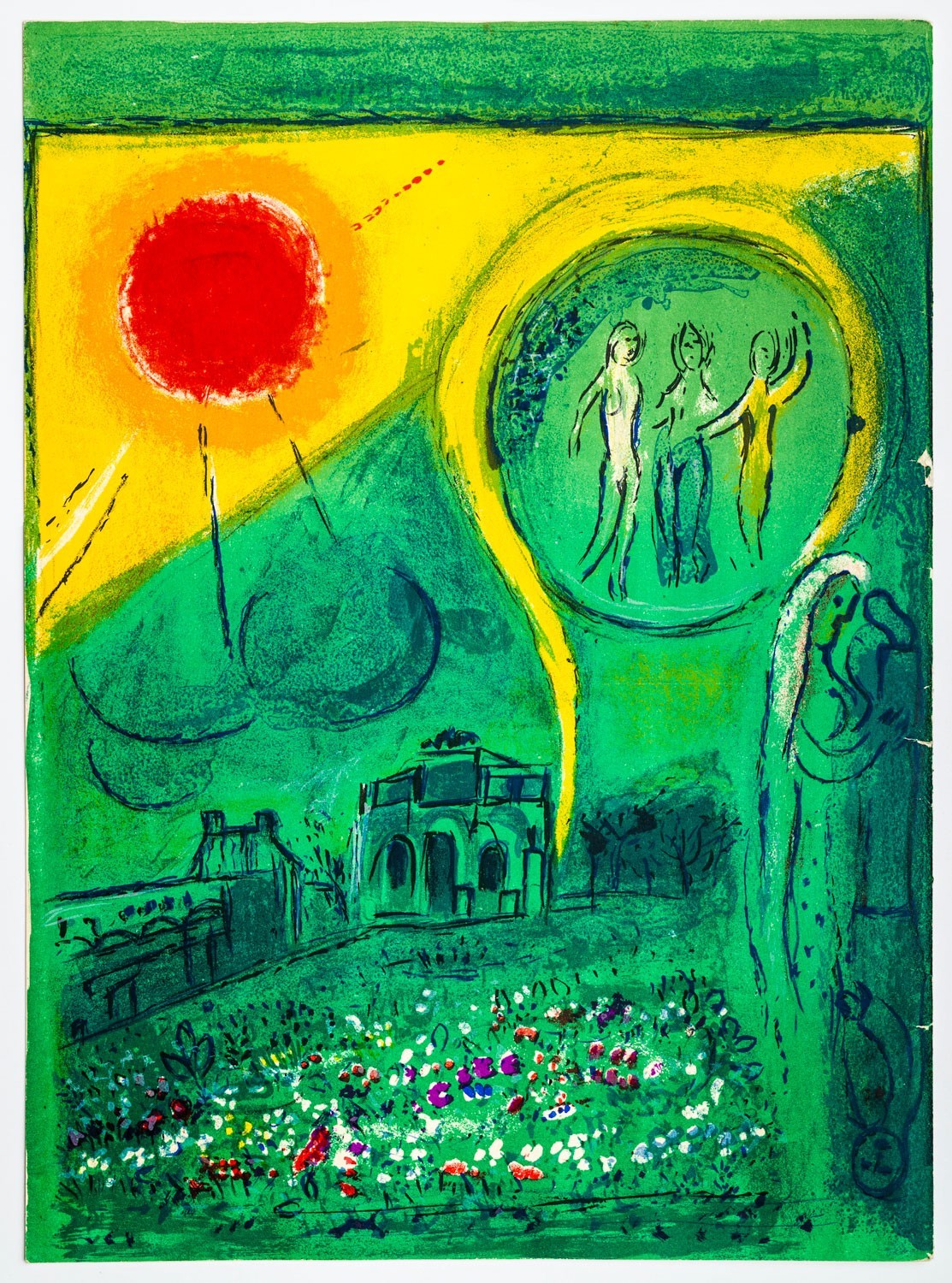
Marc Chagall, Le Carrousel du Louvre, lithograph, 28×38cm, 1954
It is obviously irresponsible to define Chagall as a painter of innocence and romance because his paintings have bright colors and rich emotions. Chagall went to Paris and was influenced by the modern art that was in full swing there. His work changed from the dullness and sadness of his creations in Russia to bright colors and forms, with sincere emotion. Similarly, after experiencing national cleansing, the death of his beloved wife, and the rejection of artistic ideas, he moved to France, Russia, Germany, the United States and other places. After being questioned because of his Jewish identity when he was middle aged, his emotions became more complicated. In works such as “Time is a River Without Banks” (1930-1959), “Revolution” (1937), and “White Crucifixion” (1938), the artist uses a heavy tone to describe his dissatisfaction with the revolution, his sympathy for his compatriots, and in his own silent resistance, he said: “Use my canvas to draw everything down to keep them away from harm.”
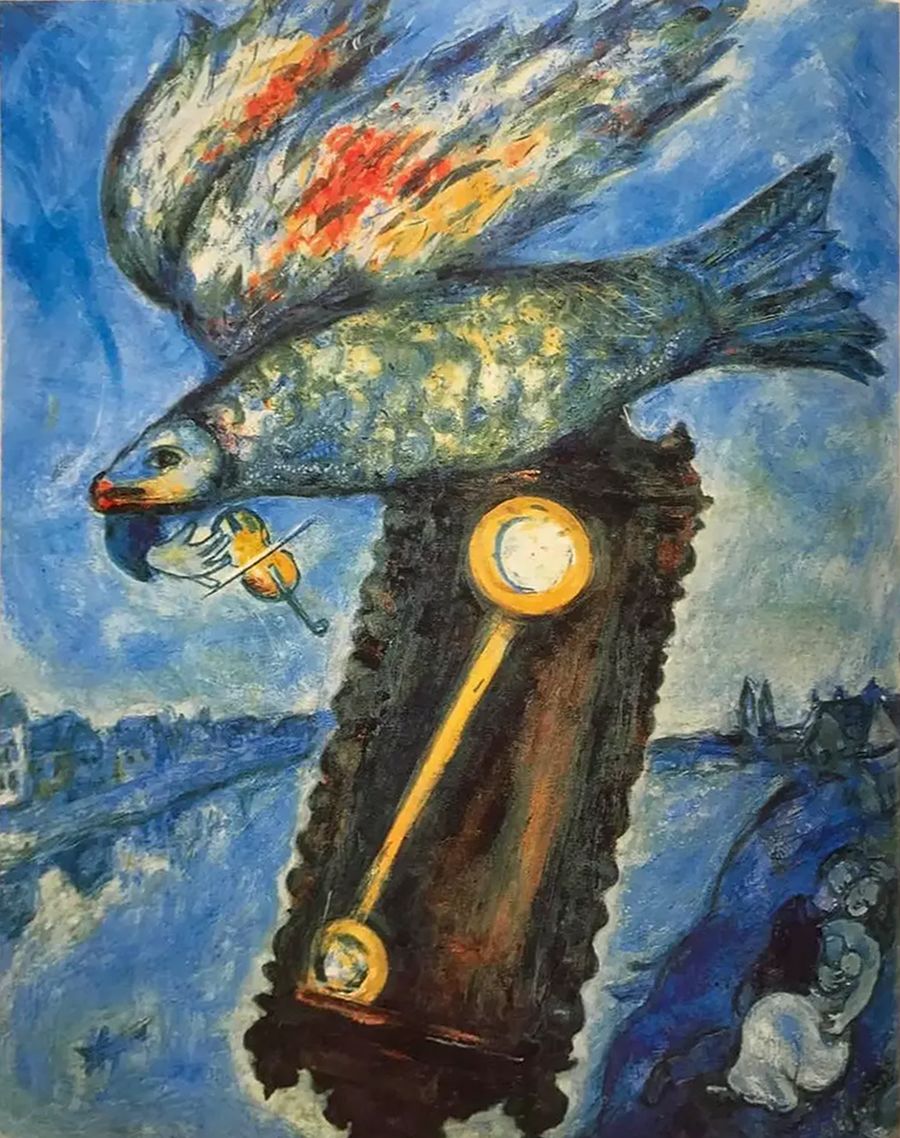
Marc Chagall, Time is a River Without Banks, 1930-1959
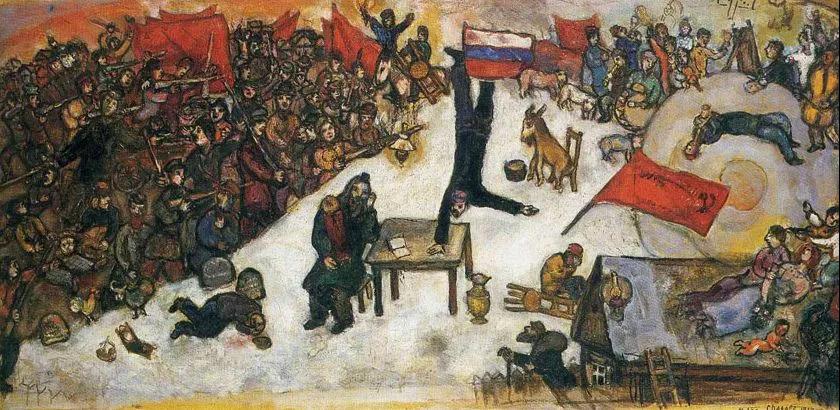
Marc Chagall, Revolution, 1937
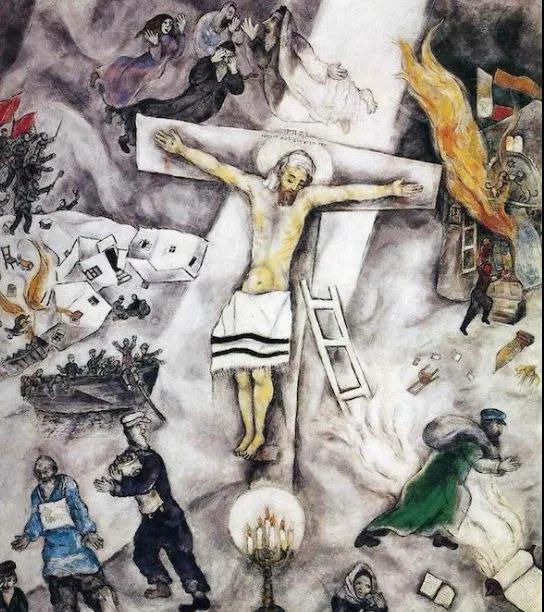
Marc Chagall, White Crucifixion, 1938
Chagall’s art has always paid attention to the subject of “Circus” since 1914, and the circus is related to the religion of suffering in his creation. He said: “I always treat clowns, acrobats, and actors as tragic characters. To me, they are like characters in certain religions. Today, when I draw a picture of the crucifixion or a painting of other religions, I have the same feeling as the characters in the circus.” Does the expression and depiction of religion originate from the Jewish faith, or does it inscribe the multiple sufferings of the Jewish ethnicity? Chagall’s art rarely depicts realistic scenes, but a series of symbolic images and heavy colors all show the artist’s deep thinking about social reality and his concern for the future.
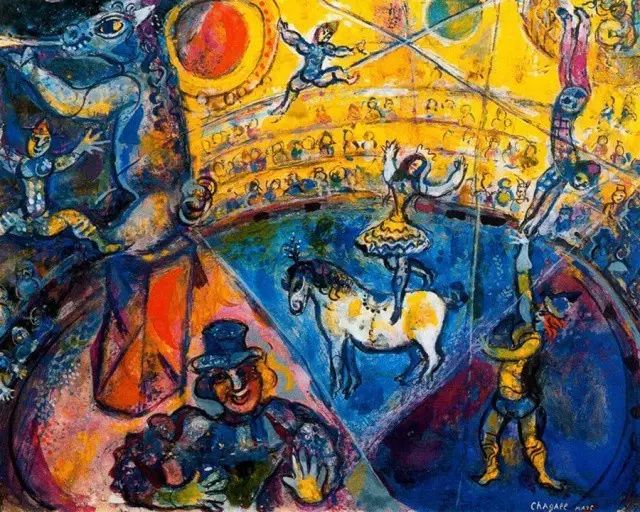
Marc Chagall, Circus Horse, Oil on canvas, 1964
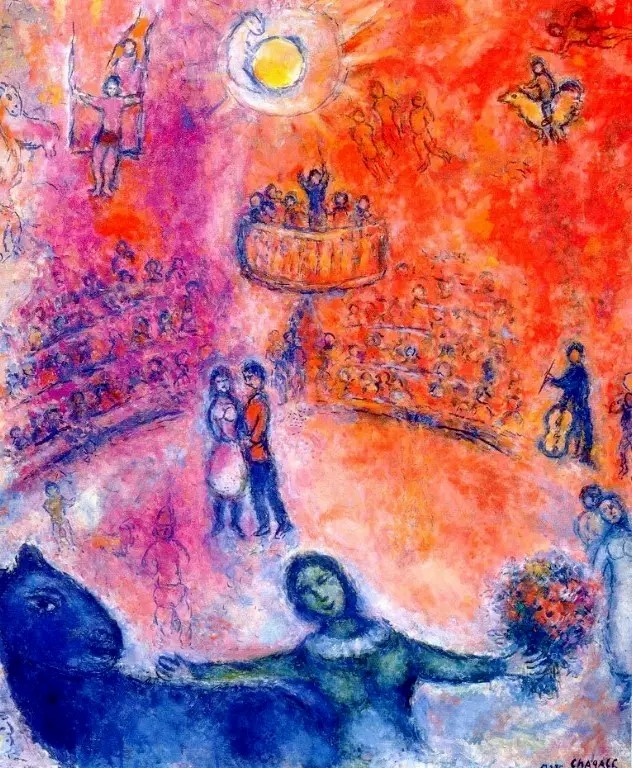
Marc Chagall, Circus, Oil on canvas, 1980
Life Ends with a Bouquet of Flowers
In Chagall’s art, flowers can always be found. When he holds Bella, there is a bouquet of flowers, when he kisses Bella, there is a bouquet of flowers... Chagall’s happiness is accompanied by a bouquet of flowers. He projects the experience of life into the daily expression of a bouquet of flowers, “Life ends with a bouquet of flowers.”
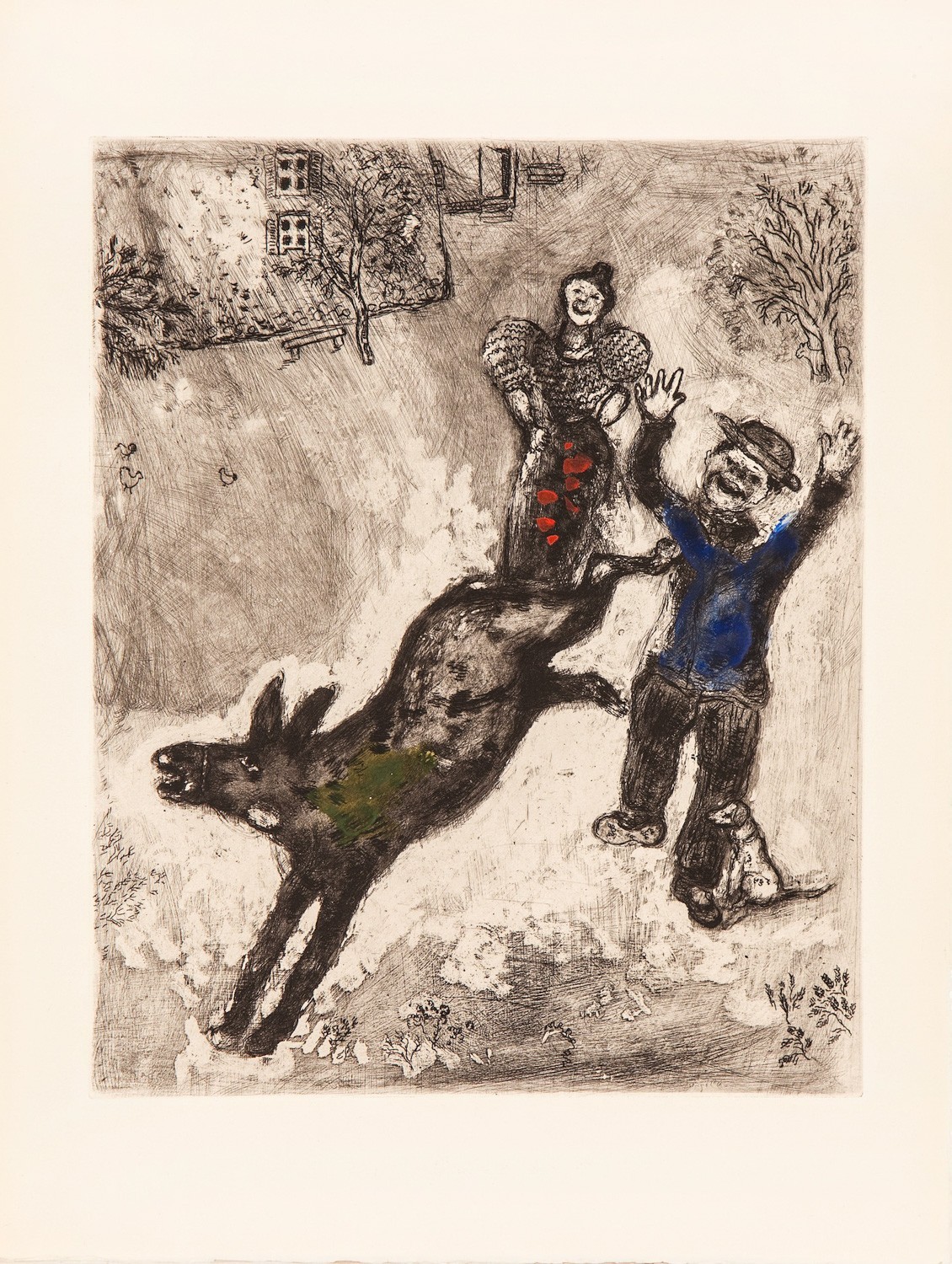
Marc Chagall, The Donkey and the Dog from Les Fables de la Fontaine, Hand colored etching, 29.5×24cm, 1927-30-52
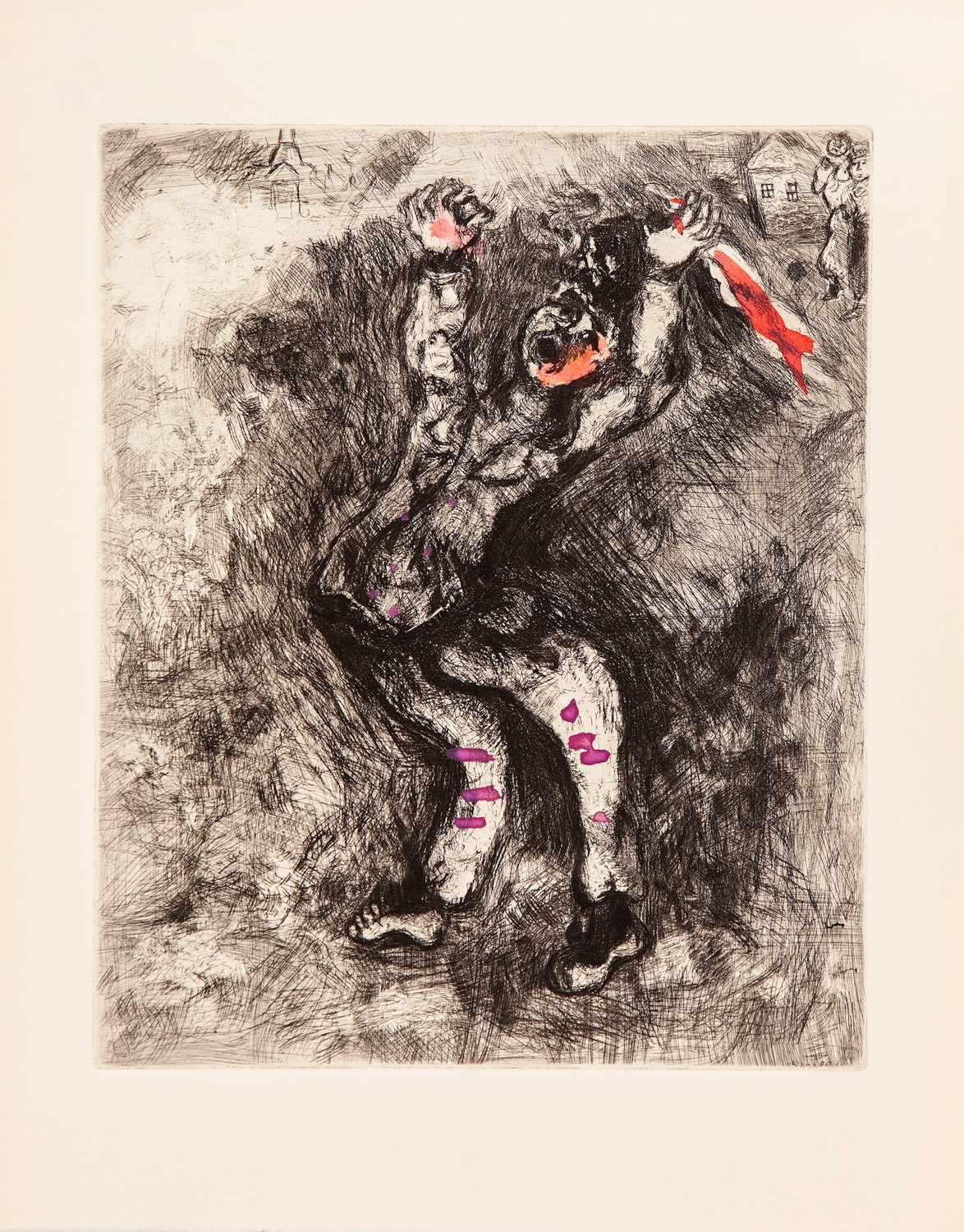
Marc Chagall, The Fool Who Sold Wisdom from Les Fables de la Fontaine, Hand colored etching, 29×23.8cm, 1927-30-52
The original surname of Chagall’s family was “Segal”, but it was renamed "Shagal" when his father was born, which means “striding forward” in Russian. Chagall was originally named Moyshe Shagal, but when he first went to Paris, he changed his name to Marc Shagal with the French pronunciation. In this art capital, he found the strength of inspiration and faith. Chagall strode forward in Paris and his art is rich and diverse—his themes involve religion, love, nostalgia, circus, etc. The forms include oil painting, watercolor, gouache, Tempera, etching, lithographs, glass paintings, and so on.
Understanding and discussion around Chagall are mostly concentrated in his paintings, but his prints also contain his sincere emotion and bold imagination. In 1922, Chagall began to learn various printmaking techniques while he stayed in Berlin, Germany. At first, he worked with a printmaker to produce corroded copperplate illustrations of his autobiography “My Life”. After that, he started to create prints and was acquainted with his important partner in printmaking, art dealer Ambroise Vollard, and at his invitation, Chagall successively accepted commissioned illustrations for Gogol’s novel Dead Souls and La Fontaine’s Fables and the Bible.
In his later years, Chagall gradually preferred expressive lithographs. His representative lithograph, “Daphnis and Chloe”, uses the characteristics of lithograph coloring, points and delicate colors to portray the aesthetic and romantic emotions of the story. In addition, he continues to experiment with ceramics, glass paintings, tapestries, etc. to release his artistic passion.
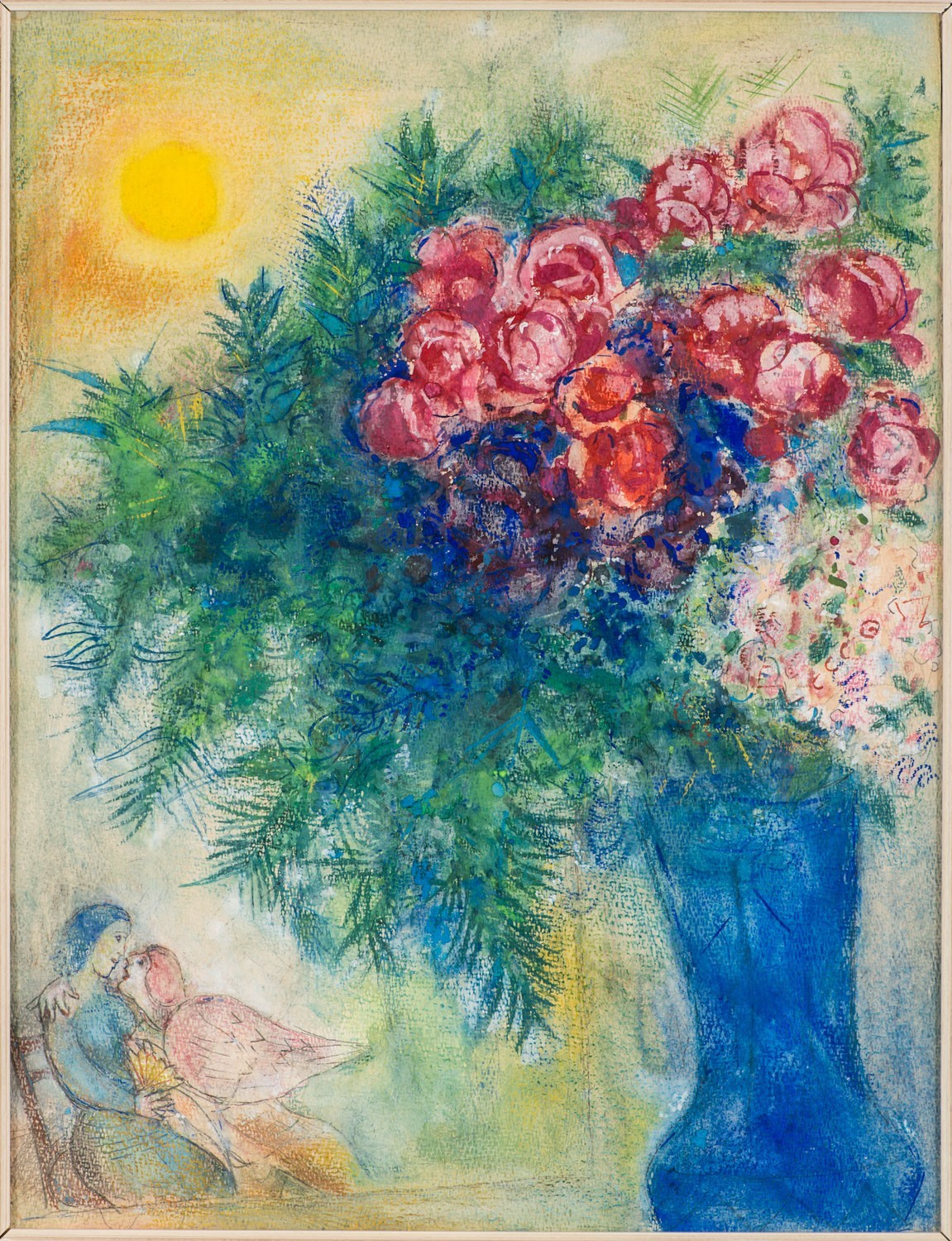
Marc Chagall, Lovers with Flowers, Mixed-material painting, watercolor, gouache, pencil, paper, 66×52cm, 1935-1938
In 1973, Chagall’s diverse artworks were opened to the world in the museum named after him. They were gathered together like a bouquet of Chagall’s works: brilliant, eternal and beautiful. In 1985, this great artist passed away at the age of 98. The bouquet-like art that he left behind accompanied him to the end of his life and touched the whole world.
Text by Yang Zhonghui, edited and translated by Sue/CAFA ART INFO
Photo Courtesy of the Organizer
References:
[1]. “Chagall’s Life and Art”, (Russia) Gil Balensky, translated by Han Wen: “Classic Library 3 Chagall”, Changsha: Hunan Fine Arts Publishing House, 2017.12, p5- 23;
[2]. Shen Ying, “The Appearance of National Consciousness—Chagall: From “Jewish Experience” to “Biblical Enlightenment”, Central Academy of Fine Arts 2004 Master’s Thesis;
[3]. Fang Hua, “Reinterpreting Chagall”, firstly published in Art Observation, Issue 06, 2002, p72-75.
[4]. Yang Miaolei, “Analysis of Animal Images in Chagall’s Paintings”, 2016 Master’s Thesis of Shanxi University.




























